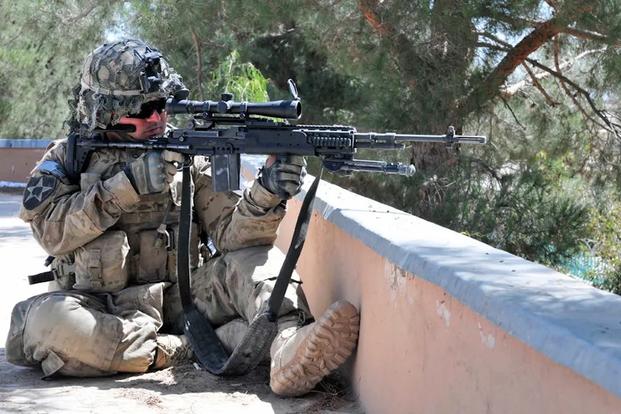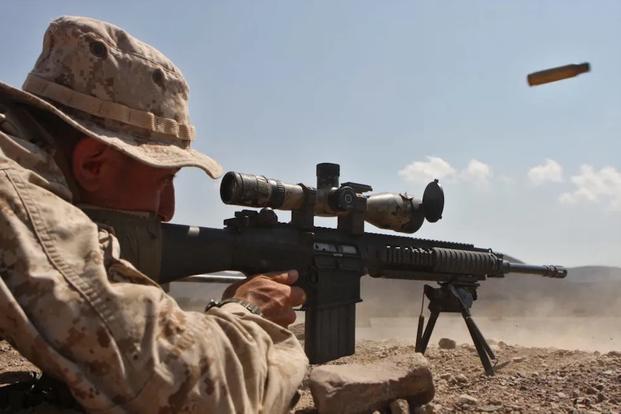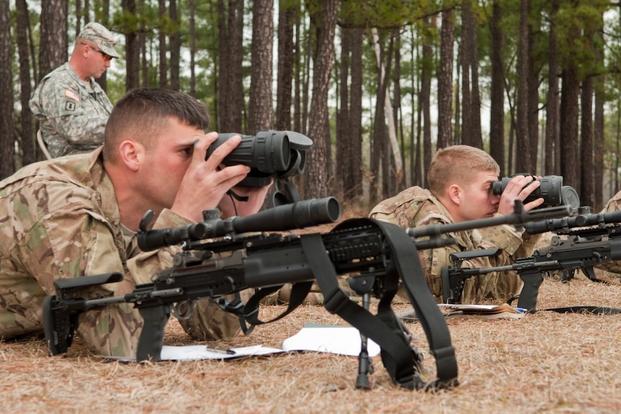The M14 is one of the worst DMRs in history, and should have never been adopted by the military.
That's a powerful statement, but a mostly objective one.
While the M14's design originated from what General Patton dubbed "The greatest battle implement ever devised" — the M1 Garand — by the 1950s it was already outdated. Military small arms development had seen unparalleled growth throughout World War II and this growth continued into the Cold War.

Experience in WWII and the frozen hell of Korea hammered home the importance of increased firepower without sacrificing range, reliability or power. Hundreds of soldiers reported the smaller M1 Carbine and its light .30-caliber cartridge were ineffective against winter-coat-wearing Chinese and Korean human wave attacks, but the .30-06 M1 never suffered this problem. Interestingly, post-war investigations suggested the M1 Carbine's light weight and high cyclic rate of fire were more responsible for this lack of stopping power than the cartridge itself — meaning, most soldiers simply missed their targets because of the gun's recoil.
This is a lesson the Army forgot when it pressed a select-fire .308 rifle into service only a few years later.
Enter, the M14.
The one thing the M14 has going for it, is its method of operation. It's a long-stroke, piston-driven action that's very similar to the most prolific, assault rifle in history: the AK-47. Like the AK, the M14's action can tolerate debris and fouling better than the direct-impingement M16. While the rifle's hard-hitting 7.62x51mm NATO round is vastly superior to the M16's 5.56mm at defeating light cover and the dense foliage found in South East Asian jungles, it also makes the rifle very tough to control.
On a side note, carrying a combat load of 7.62 isn't much fun, and doesn't offer the average infantryman nearly as much firepower as the same weight in 5.56 rounds.
But that's not what makes the M14 so awful. It's the design itself – especially for the role it has been shoehorned into: the Designated Marskman Rifle. The vaunted DMR bridges the gap between the M4 and dedicated sniping weapon systems like the M24. Infantrymen from every branch fielding a DMR in combat have nothing but praise for the guns' performance in the vast expanses of Iraq and Afghanistan.
So, if soldiers love the gun, it must be pretty decent, right? Sure, so long as the rifle is clamped into a very heavy, expensive chassis and the soldier carrying it never drops it, or touches the handguards. Seriously, disturbing the gun's bedding – the way it's glued into a stock — doesn't just shift point of impact, it reduces overall accuracy. Therein lies the biggest problem with the M14: accurizing the rifle and holding on to that accuracy.
Accuracy is a measure of consistency when it comes to rifles. Given that a DMR must, by definition, extend the effective range of a squad, its DMR needs to reliably hit targets beyond the reach of the infantryman's standard rifle or carbine. Yet, according to military standards, acceptable accuracy from the M14 is 5.5 inches at 100 yards – a full inch larger than the M16's standards. While the M14's 7.62mm round is great for this, the gun is not.
Camp Perry shooters have long since abandoned the M14 because of the difficulty in accurizing the rifle compared to the M16 – and they aren't alone. The Army noticed the problems and prohibitive costs associated with maintaining M14s in country, which lead to the solicitation of a replacement rifle to meet new specifications for the Semi-Automatic Sniper System program.
Funny thing, the Army decided the M16 was more accurate, and more easily tuned into a sniper rifle – except for the caliber. Which is why the M14 EBR's replacement, the Mk-11, is built off an AR-10: the 7.62 big brother of the M16.

In all fairness, the Global War on Terror presented a combat theater the U.S. military wasn't prepared to fight in. Plus, the M14 wasn't meant to be a sniper or DMR platform when it was developed in the 1950s. Even still, Armalite had been producing civilian and military AR-10 rifles since the late 1950s, and could have just as easily been pressed into service.
Better yet, since the AR-10 shares it's method of operation with the M16, advancements on one could likely be applied to the other. And, the guns shares the same manual of arms, so no additional training is required for soldiers transitioning from one to the other.
MORE POSTS FROM WE ARE THE MIGHTY:
7 of the best Vietnam TV shows and movies, ranked
7 dumb things troops do the first week home after a deployment
Watch this soldier pull off the ultimate homecoming surprise at the State of the Union
We Are The Mighty (WATM) celebrates service with stories that inspire. WATM is made in Hollywood by veterans. It's military life presented like never before. Check it out at We Are the Mighty.
















